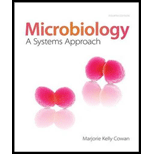
To determine:
The others animals that can develop influenza infections.
Concept introduction:
Influenza virus belongs to class V that contains negative sense single-stranded segmented RNA as their genetic material. They have enveloped virus that contains an antigen on their envelope. It is the causative agent of flu and has the ability to change its surface antigens by forming a new combination of antigen through the process called as antigenic shift.
Explanation of Solution
Influenza virus hijacks the host cell and produces more viruses, which spread to the other cells. The symptoms include cough, fever, sore throat, stuffy nose, body and headache along with restlessness. This virus has swept across the globe in waves, killing millions of people. Strains of influenza can infect pigs, dogs, birds, horses, ferrets, pigs, and cats.
The others animals that can develop influenza infections include pigs, dogs, birds, horses, ferrets, pigs, and cats.
To determine:
The possible consequences of influenza virus transmission between animals and humans.
Concept introduction:
Influenza is a tiny viral particle contains negative sense single-stranded segmented RNA as their genetic material and a protein coat. It hijacks the host cell and produces more viruses which spread to the other cells.
Explanation of Solution
The influenza virus has the ability to form new surface antigens by the mixture of antigens present on the surface of the envelope of two different strains of the virus. This process is called as antigenic shift. There are sixteen different types of H antigens and nine different types of N antigens are available. Each viral type contains a numbered type of each N and H antigen on its capsid. Strains of influenza can infect pigs, dogs, birds, horses, ferrets, pigs and cats.
Although transmission of strains from animal to humans is rare, according to scientists, it does occur. Genomic analysis of some pandemic strains has revealed that some avian genes are present in human influenza viruses. Swine influenza virus is not usually transmitted to humans but some variants have been found to infect humans.
This has occurred due to the close contact of humans with pigs and pigs can contract both avian and human influenza. Thus, there are high chances that several viruses circulate in the same organism at once. This ability contributes to the production of novel variant stains that occurred during 2009 swine flu. Analysis of such strain revealed the presence of two different genes in addition to human and avian influenza viral sequence. Therefore, it became known to scientists as “quadruple reassortant” influenza virus.
The possible consequence of influenza virus transmission between animals and humans is the production of novel variant stains.
Want to see more full solutions like this?
Chapter 6 Solutions
Microbiology: A Systems Approach
- Describe the principle of homeostasis.arrow_forwardExplain how the hormones of the glands listed below travel around the body to target organs and tissues : Pituitary gland Hypothalamus Thyroid Parathyroid Adrenal Pineal Pancreas(islets of langerhans) Gonads (testes and ovaries) Placentaarrow_forwardWhat are the functions of the hormones produced in the glands listed below: Pituitary gland Hypothalamus Thyroid Parathyroid Adrenal Pineal Pancreas(islets of langerhans) Gonads (testes and ovaries) Placentaarrow_forward
- Describe the hormones produced in the glands listed below: Pituitary gland Hypothalamus Thyroid Parathyroid Adrenal Pineal Pancreas(islets of langerhans) Gonads (testes and ovaries) Placentaarrow_forwardPlease help me calculate drug dosage from the following information: Patient weight: 35 pounds, so 15.9 kilograms (got this by dividing 35 pounds by 2.2 kilograms) Drug dose: 0.05mg/kg Drug concentration: 2mg/mLarrow_forwardA 25-year-old woman presents to the emergency department with a 2-day history of fever, chills, severe headache, and confusion. She recently returned from a trip to sub-Saharan Africa, where she did not take malaria prophylaxis. On examination, she is febrile (39.8°C/103.6°F) and hypotensive. Laboratory studies reveal hemoglobin of 8.0 g/dL, platelet count of 50,000/μL, and evidence of hemoglobinuria. A peripheral blood smear shows ring forms and banana-shaped gametocytes. Which of the following Plasmodium species is most likely responsible for her severe symptoms? A. Plasmodium vivax B. Plasmodium ovale C. Plasmodium malariae D. Plasmodium falciparumarrow_forward
- please fill in missing parts , thank youarrow_forwardplease draw in the answers, thank youarrow_forwarda. On this first grid, assume that the DNA and RNA templates are read left to right. DNA DNA mRNA codon tRNA anticodon polypeptide _strand strand C с A T G A U G C A TRP b. Now do this AGAIN assuming that the DNA and RNA templates are read right to left. DNA DNA strand strand C mRNA codon tRNA anticodon polypeptide 0 A T G A U G с A TRParrow_forward
 Human Anatomy & Physiology (11th Edition)BiologyISBN:9780134580999Author:Elaine N. Marieb, Katja N. HoehnPublisher:PEARSON
Human Anatomy & Physiology (11th Edition)BiologyISBN:9780134580999Author:Elaine N. Marieb, Katja N. HoehnPublisher:PEARSON Biology 2eBiologyISBN:9781947172517Author:Matthew Douglas, Jung Choi, Mary Ann ClarkPublisher:OpenStax
Biology 2eBiologyISBN:9781947172517Author:Matthew Douglas, Jung Choi, Mary Ann ClarkPublisher:OpenStax Anatomy & PhysiologyBiologyISBN:9781259398629Author:McKinley, Michael P., O'loughlin, Valerie Dean, Bidle, Theresa StouterPublisher:Mcgraw Hill Education,
Anatomy & PhysiologyBiologyISBN:9781259398629Author:McKinley, Michael P., O'loughlin, Valerie Dean, Bidle, Theresa StouterPublisher:Mcgraw Hill Education, Molecular Biology of the Cell (Sixth Edition)BiologyISBN:9780815344322Author:Bruce Alberts, Alexander D. Johnson, Julian Lewis, David Morgan, Martin Raff, Keith Roberts, Peter WalterPublisher:W. W. Norton & Company
Molecular Biology of the Cell (Sixth Edition)BiologyISBN:9780815344322Author:Bruce Alberts, Alexander D. Johnson, Julian Lewis, David Morgan, Martin Raff, Keith Roberts, Peter WalterPublisher:W. W. Norton & Company Laboratory Manual For Human Anatomy & PhysiologyBiologyISBN:9781260159363Author:Martin, Terry R., Prentice-craver, CynthiaPublisher:McGraw-Hill Publishing Co.
Laboratory Manual For Human Anatomy & PhysiologyBiologyISBN:9781260159363Author:Martin, Terry R., Prentice-craver, CynthiaPublisher:McGraw-Hill Publishing Co. Inquiry Into Life (16th Edition)BiologyISBN:9781260231700Author:Sylvia S. Mader, Michael WindelspechtPublisher:McGraw Hill Education
Inquiry Into Life (16th Edition)BiologyISBN:9781260231700Author:Sylvia S. Mader, Michael WindelspechtPublisher:McGraw Hill Education





